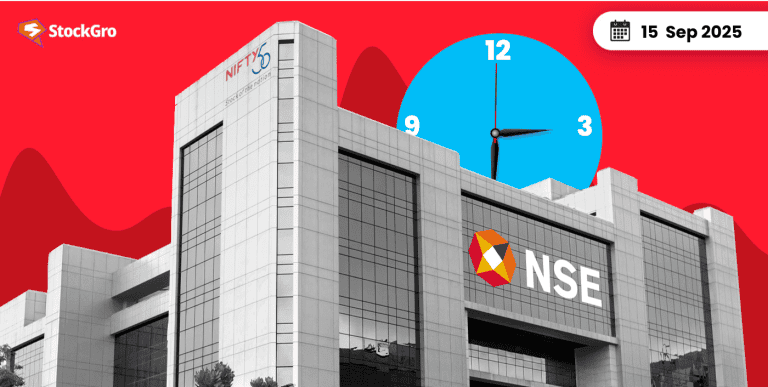
With an array of funds available to investors, analysing which mutual fund to invest in becomes crucial. However, choosing an appropriate fund requires understanding key valuation indicators such as the P/E Ratio (Price to Earnings). But before using this metric, it is also equally important to understand its significance, impact, and ideal range to ensure informed decisions.
This blog guides you on what is the P/E ratio in mutual funds, how it is calculated, and why it is essential.
What Is the PE Ratio in Mutual Fund?
P/E ratio in mutual funds is the Price-to-Earnings ratio, showing how the current share price relates to the earnings per share of the fund. For each stock, this P/E ratio shows how much investors are willing to pay per unit of company earnings. Many professionals and investors consider the P/E Ratio while evaluating the stock of companies for building strong portfolios.
Additionally, P/E ratios are also used for comparing fund performance with a benchmark or other similar funds. It is also used to distinguish between the investment styles used by different funds. For example, funds that have high P/E ratios typically follow a growth style.
How the P/E Ratio of a Mutual Fund Is Calculated
Let’s understand the P/E ratio in detail with the help of an example-
The formula of the P/E Ratio of a stock is –
P/E Ratio = Market Price Per Share(MPS) / Earnings Per Share(EPS)
In the context of mutual funds, the P/E ratio is taken as the weighted average of all individual stocks in a fund’s portfolio.
Illustration:
Suppose a mutual fund invests in 4 companies. The following table shows the P/E Ratio calculation for each.
| Company A | MPS= 500 | EPS = 40 | PE = 12.5 |
| Company B | MPS = 200 | EPS = 20 | PE = 10 |
| Company C | MPS = 400 | EPS = 25 | PE = 16 |
| Company D | MPS = 1000 | EPS = 100 | PE = 10 |
Now, let’s assume a fund manager invests in the following weightage:
₹10 lakh in Company A
₹20 lakh in Company B
₹30 lakh in Company C
₹20 lakh in Company D
Then, here’s how you can calculate the P/E ratio of the Mutual Fund.
Step 1: Total investment
10+20+30+20=80
Step 2: Weight (W) of each company stock
W(A) = 10/80 = 0.125
W(A) = 20/80 = 0.25
W(A) = 30/80 = 0.375
W(A) = 20/80 = 0.25
Step 3: Weight * PE of each stock
0.125*12.5 = 1.5
0.25*10 = 2.5
0.375*16 = 5.9
0.25*10 = 2.5
Step 4: Sum the weighted values
1.5+2.5+5.9+2.5= 12.46
Therefore, the P/E Ratio of Fund = 12.46
Why PE Ratio Matters to Investors
The P/E ratio is a simple valuation metric that can be used for analysing different funds. Let’s understand why it matters to investors:
- Determining Risk: A higher P/E ratio often involves high risk and can be overvalued. A low P/E ratio indicates undervaluation.
- Fund objective assessment: A High P/E ratio reflects that the fund is investing in growth-oriented stocks; on the other hand, a low P/E ratio indicates a focus on value-oriented stocks.
- Comparison: The P/E ratio is also used for comparing the fund’s performance with respect to the benchmark index and other similar funds.
.
Interpreting PE Ratio: High vs Low
Use this table to compare and interpret different P/E ratios across different funds:
| High P/E Ratio Funds | Low P/E Ratio Funds |
| Invest in stocks that have high growth potential | Invest in relatively stable stocks |
| Often considered overvalued | Typically Undervalued |
| High risk | Low risk |
Therefore, neither a high nor a low PE ratio is good or bad; instead, it reflects the investment style and objective of the funds, so that an investor can find a suitable fund that contributes to their financial goals.
What Is a ‘Good’ PE for Mutual Funds?
There is no specific definition of a ‘Good’ P/E Ratio for mutual funds. Theoretically, some categories of funds normally have a high P/E Ratio, while others tend to have a low P/E ratio. Since small-cap and mid-cap funds usually invest in companies that have a strong growth potential, their P/E ratios are usually high. On the other hand, large-cap funds and value funds typically have low P/E ratios.
However, let’s check out the reality:
| Fund name | P/E Ratio (as of 31st Aug, 2025) |
| Canara Robeco Small Cap Fund | 25.92 |
| HDFC Mid Cap Fund | 23.98 |
| Bandhan Value Fund | 21.09 |
| DSP Large Cap Fund | 19.03 |
This serves as evidence that there is no good or bad range of P/E ratio. However, it is ideal to consider the factors below to further examine the P/E ratio:
Market Conditions – Usually, in a bull market, the P/E ratio of companies rises. On the other hand, in a bear market, the P/E of companies falls.
Benchmark Comparison: A P/E ratio of a fund must be compared with the benchmark that aligns with the fund’s portfolio.
Funds Allocation – Funds with higher allocation towards equity have a higher P/E ratio, while funds that have a large allocation towards debt have a lower P/E ratio.
Limitations & Considerations
Despite its simplicity, the P/E ratio comes with certain limitations:
Measure of the past: The P/E ratio is calculated using past data; therefore, it may not be currently reliable.
No ideal level – P/E ratio can be considered inconsistent, as the ideal range differs sector to sector.
Standard Measure – P/E ratio is not a standard measure; there is no universally predefined value to define fund performance through P/E.
Narrow perspective – The P/E ratio only considers the valuation aspect of the stock, keeping the fundamental side of the stock untouched for fair analysis. Therefore, it may have to be considered with other suitable valuation methods.
PE Ratio vs Other Valuation Metrics (PEG, P/B, EV/EBITDA)
| Aspects | P/E | PEG | P/B | EV/EBITDA |
| Full Form | Price to Earnings | Price to Earnings Growth Ratio. | Price to Book Ratio | Enterprise value(EV)/ EBITDA(Earning before interest, tax, depreciation and amortisation) |
| Formula | Market price per share(MPS)/ Earning price per share (EPS) | PE/ Earning Growth rate | MPS/ Book value per share | EV/EBITDA |
| Insights | The P/E ratio gives results based on the earnings of the company | More accurate than PE because it also considers the growth aspect | It reflects the valuation based on the assets of the company | It reflects a broad picture of valuation as it takes into account the debt and cash flows of the company |
Conclusion
The P/E ratio in mutual funds provides insight into how a fund’s portfolio is valued relative to its earnings. A high or low P/E ratio does not necessarily indicate good or bad performance; instead, it reflects the fund’s strategy and investment style. The P/E ratio is also influenced by factors such as market fluctuations, sector composition, and fund category. Therefore, investors should avoid relying solely on the P/E ratio and consider additional valuation metrics like PEG, P/B, and EV/EBITDA for a more balanced investment assessment.
FAQs
The P/E Ratio is defined as the price to earnings ratio, which is a popular financial valuation ratio that shows how much investors are willing to pay in comparison to a company’s earnings.
Along with the P/E ratio, investors often consider other valuation metrics such as the P/B ratio, the PEG ratio, and EV/EBITDA. The P/E ratio alone may generate a skewed analysis.
A mutual fund’s P/E ratio is calculated by using the weighted average of the P/E ratios of stocks in the fund’s portfolio. The formula for the P/E ratio of a stock is:
P/E Ratio = Market Price Per Share(MPS) / Earnings Per Share(EPS).
The P/E ratio has limitations such as sector bias, lack of a universal benchmark, and a reliance on historical data. It also does not account for factors like company assets, cash flow, or management quality.
A high P/E is neither good nor bad; it means that the fund invests in high growth potential stocks, but at times it can be a sign of overvaluation.
According to multiple sources, the P/E ratio differs across different categories of funds. Ideally, for an equity mutual fund, a P/E ratio between 17 and 25 is considered considerable.

